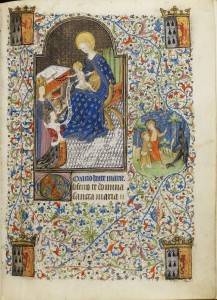Optical microscopy is used to support and clarify the results of spectroscopic analyses, assess the conditions of the paint layers, document damage, and suggest the presence of pigment mixtures, layers, glazes and alteration compounds. It is an indispensable tool for revealing painting techniques such as modelling of draperies and flesh tones. Microscope images are included in the majority of the hotspots you can explore on this website.
Our manuscripts were observed under magnification using a Leica M80 stereomicroscope equipped with a 1.0x planar lens, yielding magnification ranging from 7.5x to 60x. A Canon camera was fitted onto the microscope via a T2 attachment and extension, allowing us to record high-resolution digital images of the observed areas.
Occasionally we observed manuscripts under raking light, i.e. by placing the light at an oblique angle rather than directly above the page, in order to better record the surface texture of the paint layers.
































